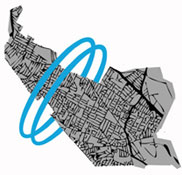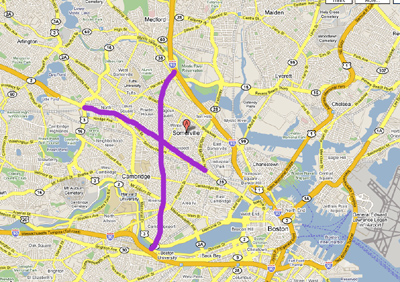
| 2010s | - | 2020s | - | 2030s | - | 2040s | - | 2050s | - | 2060s | - | 2070s | - | 2080s | - | 2090s | - | 2100 | |
| 2020 | - | 2021 | - | 2022 | - | 2023 | - | 2024 | - | 2025 | - | 2026 | - | 2027 | - | 2028 | - | 2029 |
|
Increased car
use leads to the construction of two major highways that cut through
Somerville in the 2020s. Click on a decade or year above to read about the future.
|
Introduction to the 2020s Despite the economic downturn of the 2010s, Somerville residents continue on, still focused on their health, on the environment, and on being nice to people. The city has become the area's vegan capital, a leader in the worldwide uptick in vegetarianism of the 2010s. Davis Square is now carbon-neutral. Rounder Records, which returned to Somerville in 2017, is now a major force in the record industry; it acquires CBS/Sony, EMI and Virgin. The City of Somerville also expands, taking Porter Square in 2025, in order to help Cambridge stay afloat financially. The city puts a roof over the parking lot, which is made available to residents for community gardens. The city continues to expand, taking Inman from Cambridge in 2027; no reason or justification is given for this action. This time period sees radical and unpredictable changes in how people are getting around. In the beginning of the 2020s, the city's new (and free) pedal-powered buses prove to be a popular alternative to the city's own public transit system and its ubiquitous bicycles. The Green Line is extended to Union Square and Medford for the third time. The Urban Ring line also opens. But this era of public transport quickly passes, and, by 2022, people are using cars again with a vengeance. A new highway appears through the city to facilitate car travel. A few years after this, the pendulum has again shifted back, and cars are banned completely from the city. By the end of the decade, car culture has returned, and another highway is built through the city. Nationally, hover cars make their first appearance. Biofuels are becoming more and more common in the US, and a large chunk of our electricity comes from renewables. The federal government passes laws to reduce waste and litter, inspired by Somerville's practices. Styrofoam and plastic bags are now banned; recycling bins and composting are now required. NASA continues along its own expansionistic path by colonizing the Moon. Interest in the environment is not limited to the US. All new cars produced worldwide are hybrids, and Europe is powered largely by renewable energy. This is important, since the average city dweller lives more than 25 miles from downtown, and does a lot of driving. Technology continues to make great leaps. Computers are now as intelligent as humans. More and more jobs are shifting to India and China, as the world becomes more and more wired. Corporations begin to take power from governments; traditional geographical entities such as states, regions, and even countries, lose their importance in global relations. The economies of developing countries such as Brazil surpass those of European countries. There are now more than 1 billion Muslims; as a political bloc, Islamic countries have become very powerful. These radical
changes cause people to reevaluate their lives, and the art of living
replaces materialism worldwide in the middle years of the decade.
|
